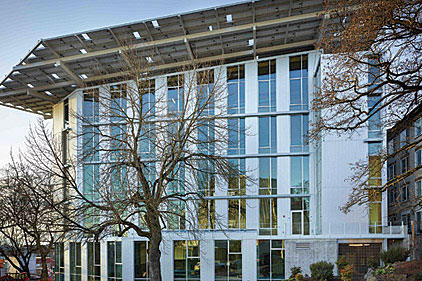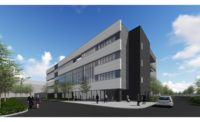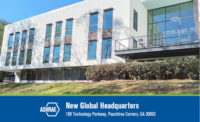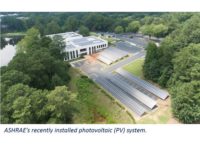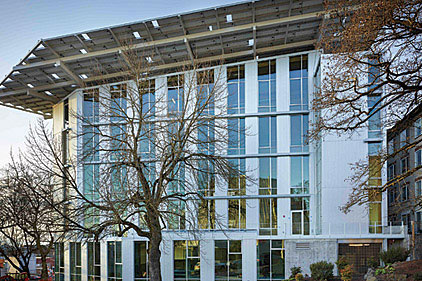
|
| The Bullitt Center employs several energy-saving systems, including heat pumps used in radiant flooring and ventilation system heat recovery. |
In the recently completed Bullitt Center office building in Seattle, net zero energy and net zero water initiatives have been combined with the Living Building Challenge.
The Living Building Challenge is a sustainable building certification program created by the non-profit International Living Future Institute. Created in 2006 and launched three years later, it was the brainchild of the Cascadia Green Building Council, which has its offices in the Bullitt Center along with other likeminded organizations. Currently, there are over 140 Living Building Challenge registered projects in 10 countries, but only three to date in the U.S. have been fully certified and they are much smaller buildings than the six-story, 50,000-sq-ft Bullitt Center.
The $30 million Bullitt Center, which opened on April 22, 2013 (Earth Day), will undergo a full year of verification against the Challenge’s 20 “Imperatives” that fall under seven performance areas (site, water, energy, health, materials, equity, and beauty).
The timber-structured Bullitt Center building was designed to be one of the most energy efficient buildings in the U.S., achieving an energy efficiency of 83% better than the typical Seattle office building. Already called the “world’s greenest commercial building,” it is meant to last 250 years, remaining independent of municipal water and sewer connections through its long operational life.
To achieve the twin Imperatives of net-zero energy and net-zero water use, the Bullitt Center comes with a geothermal system and in-floor radiant heating, a 14,000-sq-ft canted and extended rooftop filled with photovoltaic solar capture arrays to make electricity, a rainwater capture/purification system for potable systems with a 56,000 gallon basement cistern, onsite waste management through the use of water saving composting foam flush toilets (a first for a commercial building in the U.S.), and large thermally glazed curtain wall windows that open and close automatically in response to outside conditions and to maximize daylighting. Automatic controls are designed to adjust or turn-off low voltage LEDs when daylight illumination is sufficient to light interior spaces.
The center’s mechanical requirements led to the design by MEP firm PAE of a highly efficient heating and cooling system utilizing geothermal heat exchangers, in-floor radiant heating, and a climate control system that depends on natural ventilation and automated windows. The vertical closed loop geothermal system consists of 26 geothermal wells, each 400 ft deep, to tap the consistent earth temperature.
Bosch Thermotechnology’s FHP Manufacturing division’s high efficiency water-to-air (W2A) heat pump units were selected by PAE to provide heating and cooling to the center’s conference rooms, the building’s data center, and elevator machine room. FHP heat pumps connected to Uponor radiant PEX deliver Btus for radiant heating and cooling and also generate heat recovery for the ventilation system’s 100% outside air unit which preconditions incoming fresh air with outgoing air.
FHP Manufacturing ES Series and AP Series W2A heat pumps were specified for the project along with CA Series W2A pumps. All three series pumps come with copper coaxial heat exchangers and 4-way reversing valves for heating/cooling and provide very quiet operation. AP Series pumps feature a two-stage scroll compressor that when matched to a multistage thermostat, as in the Bullitt Center, matches demand for heating and cooling, making them highly energy efficient. There are a total of 10 FHP heat pumps in the Bullitt Center.
According to Justin Stenkamp, P.E., of PAE, selection of the FHP products was made on the basis of their performance characteristics along with working relationships and a strong track record for service from Bosch representatives on previous projects.
As electrical plug loads from tenants can account for as much as 50% of an office building’s energy use, the Bullitt Center’s occupants are responsible for setting and abiding by a unique lease agreement condition that sets a specific energy use limit per square feet each year.
The net-zero energy and net-zero water objectives of the Bullitt Center will have the most impact on the building’s attainment of a Living Building certification. Use of a geothermal HVAC system with dedicated on-site solar energy generation — even in cloudy climates like the Pacific Northwest — is a natural choice for Net-Zero Energy Buildings.
